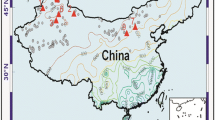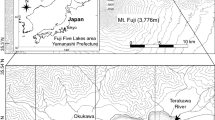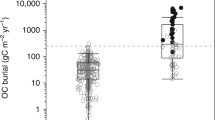Abstract
This paper reports a first estimate of the Holocene lake sediment carbon pool in Alberta, Canada. The organic matter content of lake sediment does not appear to depend strongly on lake size or other limnological parameters, allowing a simple first estimate in which we assume all Alberta lake sediment to have the same organic matter content. Alberta lake sediments sequester about 15 g C m-2 yr-1, for a provincial total of 0.23 Tg C yr-1, or 2.3 Pg C over the Holocene. Alberta lakes may represent as much as 1/1700 of total global, annual permanent carbon sequestration.
Similar content being viewed by others
References
Campbell, I. D., 1996. Power function for interpolating dates in recent sediments. J. Palaeolim. 15: 107–110.
Dean, W. E., 1974. Determination of carbonate and organic matter in calcareous sediments and sedimentary rocks by loss on ignition: comparison with other methods. J. Sed. Petrol. 44: 242–248.
Dean, W. E., 1998. The carbon cycle and biogeochemical dynamics in lake sediments. J. Paleolim. 21: 375–394.
Dean, W. E. & E. Gorham, 1998. Magnitude and significance of carbon burial in lakes, reservoirs, and peatlands. Geology 26: 535–538.
Håkanson, L. & M. Jansson, 1983. Principles of lake sedimentology. Springer-Verlag, Berlin, 316 pp.
Halsey, L. A., D. H. Vitt & D. Trew, 1997. Influence of peatlands on the acidity of lakes in Northeastern Alberta, Canada. Wat. Air Soil Poll. 96: 17–38.
Keeling, R. F., S. C. Piper & M. Heimann, 1996. Global and hemispheric CO2 sinks deduced from changes in atmospheric O2 concentration. Nature 381: 218–221.
Kemp, A. L. W., 1969. Organic matter in the sediments of Lakes Ontario and Erie. Proceedings of the 12th Conference of Great lakes Research, 1969. International Association of Great Lakes Research, 237–249.
Lehman, J. T., 1975. Reconstructing the rate of accumulation of lake sediment: the effect of sediment focusing. Quat. Res. 5: 541–550.
Mitchell, P. & E. Prepas, 1990. Atlas of Alberta Lakes. University of Alberta Press, Edmonton. 675 pp.
Rowan, D. J., J. Kalff & J. B. Rasmussen, 1992. Profundal sediment organic content and physical character do not reflect lake trophic status, but rather reflect inorganic sedimentation and exposure. Can. J. Fish. Aquat. Sci. 49: 1431–1438.
Strong, W. L., 1991. Postsettlement changes in limnic sediments from southern Alberta, Canada. Agric. Ecosyst. Environ. 36: 111–117.
Strong, W. L. & J. M. Thompson, 1995. Ecodistricts of Alberta: Summary of biophysical attributes. Alberta Environmental Protection, Resource Data Division.
Vitt, D. H., L. A. Halsey, I. E. Bauer & C. Campbell, 1999. Spatial and temporal trends of carbon sequestration in peatlands of continental Canada through the Holocene. Can. J. Earth Sci.
Webb, R. S. & T. Webb III, 1988. Rates of accumulation in pollen cores from small lakes and mires of eastern North America. Quat. Res. 30: 284–297.
Author information
Authors and Affiliations
Rights and permissions
About this article
Cite this article
Campbell, I., Campbell, C., Vitt, D. et al. A first estimate of organic carbon storage in Holocene lake sediments in Alberta, Canada. Journal of Paleolimnology 24, 395–400 (2000). https://doi.org/10.1023/A:1008103605817
Issue Date:
DOI: https://doi.org/10.1023/A:1008103605817




